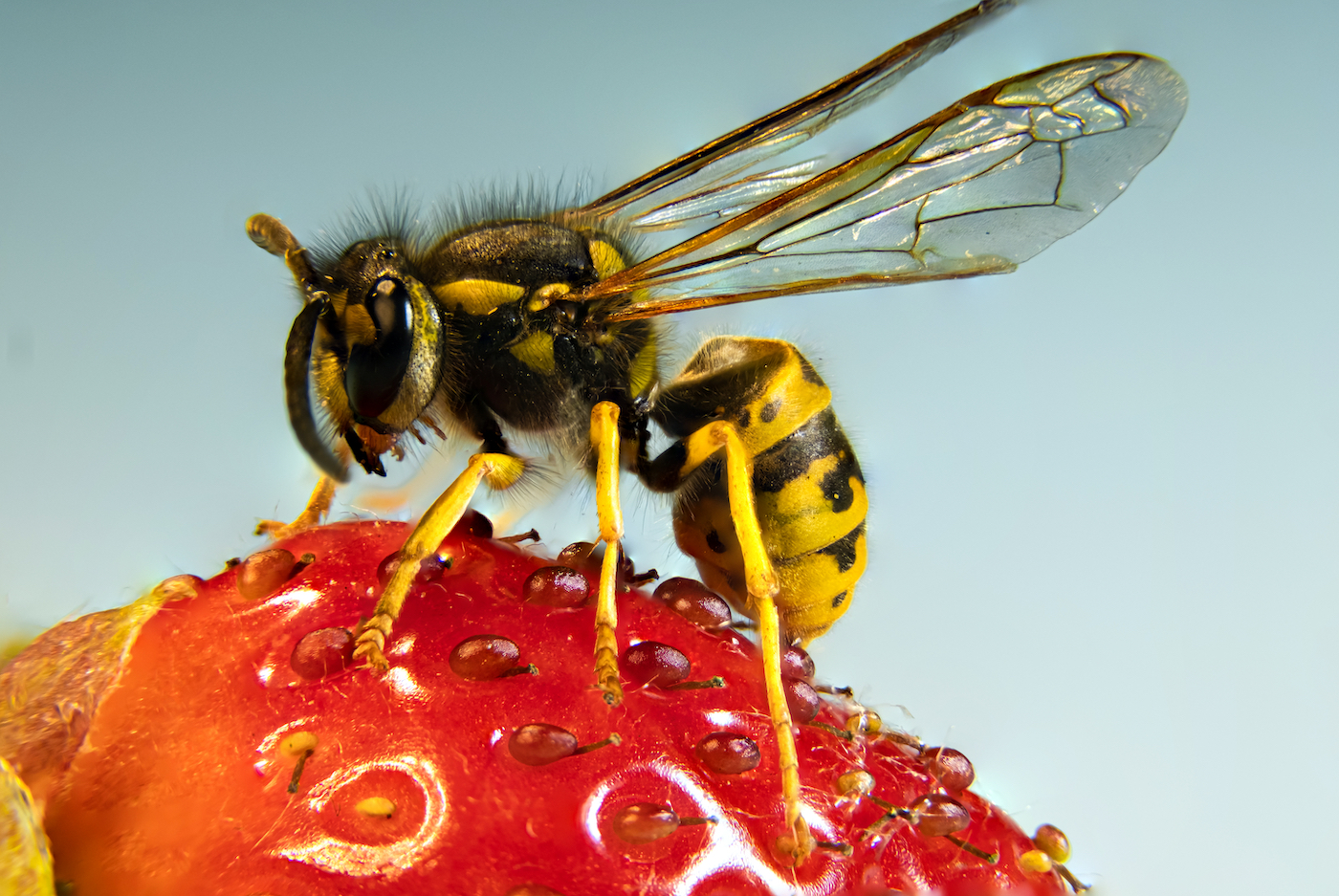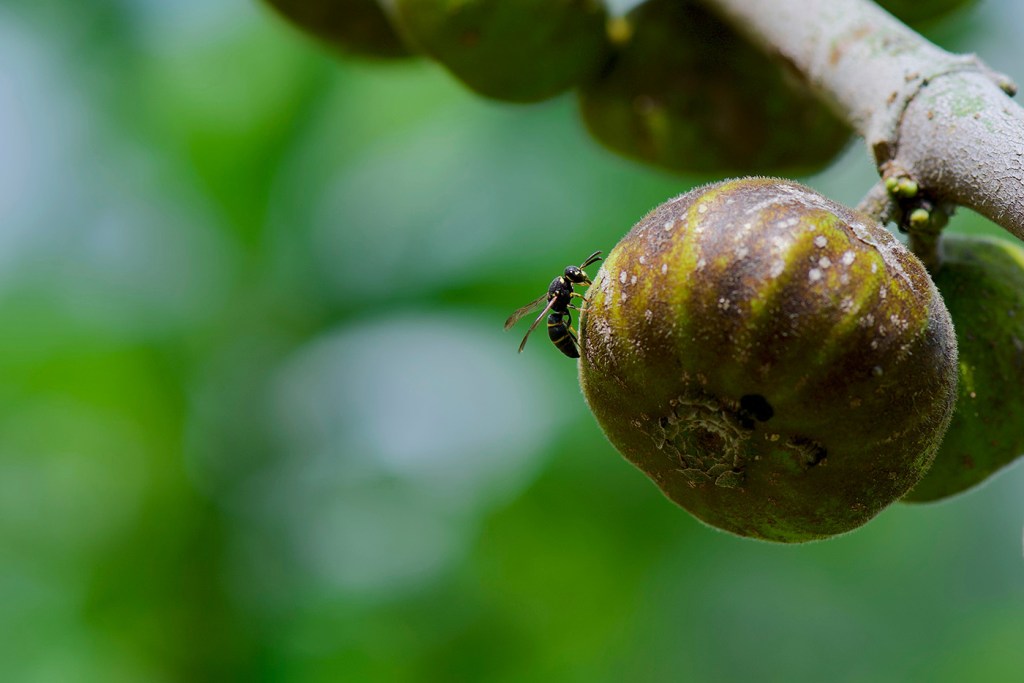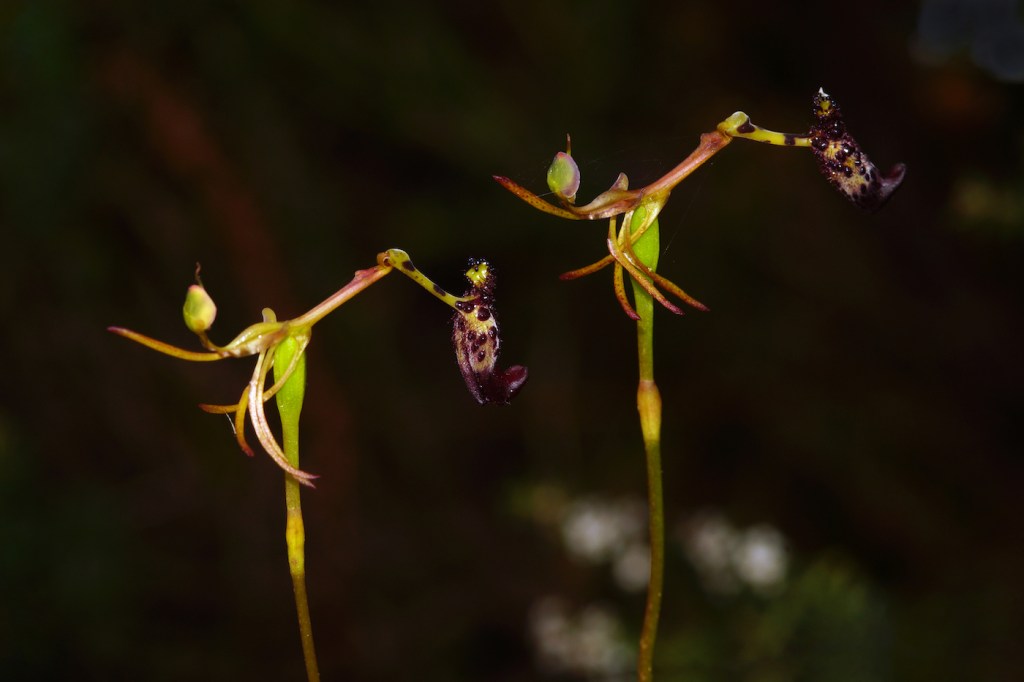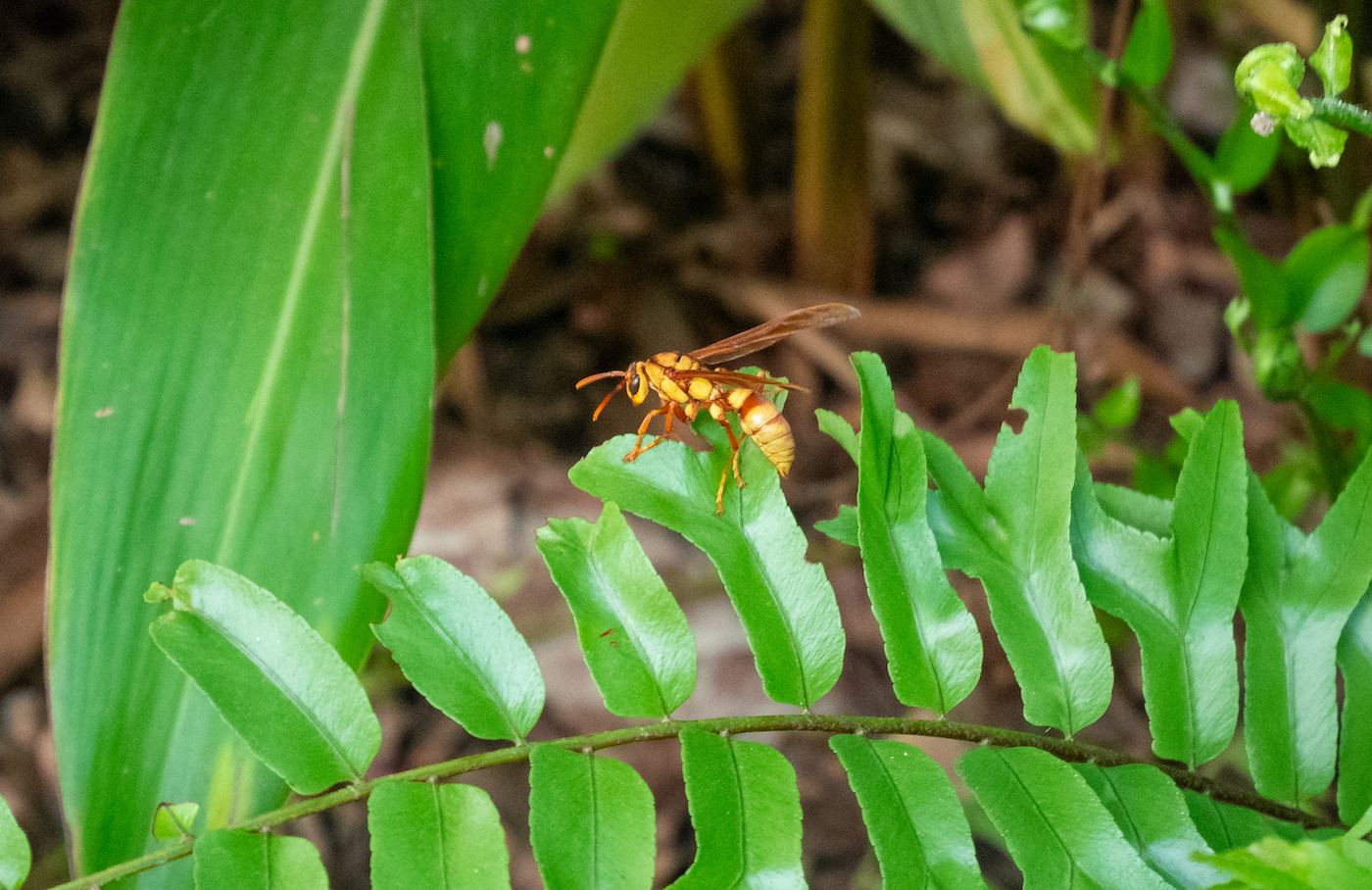Why You Should Thank Your Local Wasp
17:02 minutes

It’s late in the summer, meaning any outdoor gathering with food and drink has a good chance of being visited by a pesky, buzzing wasp. But don’t reach for that rolled-up newspaper or can of bug spray. The wasps in your world play an important role that’s often overlooked.

Far beyond the social hornets and yellowjackets people think about when they picture a wasp, the wasp world includes thousands of species. Some are parasitic, injecting their eggs into unwilling prey. Others hunt, either paralyzing prey for their young to feed on, or by bringing bits of meat back to a nest for their young. Some are strictly vegetarian, and live on pollen. Some are needed for the pollination of figs and certain species of orchids.
Dr. Seirian Sumner, a behavioral biologist at University College London, says that if people understood the services provided by wasps the same way that they understand the need for bees, they might be more willing to overlook an occasional wasp annoyance—and might even be thankful for the wasps in their lives. In her book, Endless Forms: The Secret World of Wasps, Sumner makes the case for wasps as nature’s pest control agents, as important pollinators that should be celebrated.

And the pesky yellowjacket at your picnic? It’s probably being driven by a late-summer shift in functions within the nest, in which many of the workers die off and are replaced by sexual brood. Earlier in the year, worker wasps can bring bits of meat to the developing young, which reward them with sugary secretions. But later in the season, that food source dries up—so visiting wasps are probably searching for a bit of sugar just to get by. “Watch the wasp, see what she wants at your picnic,” Sumner advises. “Is she going for sugar, or is she going for some meat? Whatever you can work out that she wants, give her a little bit of it. Make a little wasp offering.”

Sumner joins SciFri producer Charles Bergquist to talk about wasps, and make a case for why you should be thankful for the wasps in your neighborhood.
Read an excerpt of Endless Forms: The Secret World of Wasps by Dr. Seirian Sumner here.
Invest in quality science journalism by making a donation to Science Friday.
Dr. Seirian Sumner is author of ‘Endless Forms: The Secret World of Wasps,” and a professor of Behavioural Ecology at University College London.
IRA FLATOW: This is Science Friday. I’m Ira Flatow. Do you have a picnic planned for Labor Day this weekend? What’s the most annoying thing about eating outside in late summer? I’m saying it’s wasps– wasps circling your food and your head. But before I reach for the rolled-up newspaper, SciFri’s Charles Bergquist is here with another viewpoint. Hi, Charles.
CHARLES BERGQUIST: Hey, Ira I got a chance to talk with Professor Seirian Sumner. She’s a professor of behavioral ecology at University College London. And she’s also author of the book Endless Forms– The Secret World of Wasps. And she says you should be thankful for the wasps in your life.
IRA FLATOW: Thankful? You’re going to have to make a pretty strong case here, Charles.
CHARLES BERGQUIST: Well, Dr. Sumner calls wasps “nature’s pest control agents.” In fact, she says there are factories that breed thousands upon thousands of wasps for use in agriculture.
IRA FLATOW: Really?
CHARLES BERGQUIST: Yep. And if you want to control your clothes moths, but you hate that mothball smell, there’s a wasp for that, too.
IRA FLATOW: OK. Now you’ve got me interested.
CHARLES BERGQUIST: Maybe she can convince you. I started by asking her where wasps fit on the evolutionary tree.
SEIRIAN SUMNER: Well, actually, everything is a wasp. That’s what I like to start with, is that the Hymenoptera encompasses the wasps, bees, and ants. But the wasps are the root of all of those. So bees are wasps that have forgotten how to hunt, because most wasps are hunters. And ants are just wasps that have lost the ability to fly, at least in most of their life cycle. It’s only the sexuals that fly. So everything is a wasp, really. So I kind of feel that the wasps, which are generally overlooked, and everybody applauds the bees and the ants, says, well, actually, there would be no bees or ants if it weren’t for the wasps.
CHARLES BERGQUIST: So all the things that we call yellow jackets, hornets, any of these specific things where you see them and say, ooh, there’s a flying stingy thing– they’re all wasps.
SEIRIAN SUMNER: Yeah, absolutely. Yeah. But there are many different kinds of wasps. Most people think of wasps as the yellow jacket and the hornet, as you’ve just mentioned. And those are social wasps.
And actually, social wasps represent a very small proportion of the total number of wasp species that have been described. There’s over 100,000 species of wasps that have been described, and yet there’s only about 1,500 species of social wasps. And in fact, the yellow jackets that come to visit you at your picnics– even across the entire world, there are only about 70 species of those vespines, the yellow jackets and the hornets.
So actually, the social wasps that we encounter and we think of as wasps and we identify that kind of yellow and black striped buzzy thing at picnics– they are a tiny, tiny proportion of what wasps are. Most wasps don’t sting, actually. They are parasitoid wasps, which lay their eggs in or on other organisms like a caterpillar or a beetle larva.
And they don’t have stings. They have a long egg-laying sheath called the ovipositor, which they would use to lay the egg in their prey. They won’t move the prey. They’ll basically find the caterpillar that’s buried under some bark or something, they’ll lay the egg, and then they’ll leave, and that’s it. There’s no more parental care.
But it’s the hunting wasps, the stinging wasps, that we think of as being, and we recognize as being, a wasp. And there are only about 33,000 species of those. I say “only”– actually, let’s get that in perspective, because there are only 22,000 species of bees. And yet people think that bees are amazing and so diverse and incredible. Well, there are at least 33,000 species of stinging wasps. So the scales need to be balanced up here.
CHARLES BERGQUIST: It’s getting towards the end of the summer here. Tell me about the life cycle. What are my local wasps likely to be doing?
SEIRIAN SUMNER: Yeah. So your local wasps– I guess we’re talking about your yellow jacket wasps– they will have come out in the early spring. And the queens, the mated queens who’d hibernated, will have built their own nests on their own. And they will have done all the nest building. They collect wood from your garden benches, your sheds, your fences, bits of dead wood, and they will mix it with saliva, and they’ll spread it out into this beautiful, thin, papery material. And they’ll start to build what will be an incredible citadel by the end of the summer.
And the first brood that are reared will then be the workers. And once the workers have emerged as adults, they’re all her daughters, and they will then be the foragers and the nest builders and the maintenance staff. And the queen herself will never leave the nest again.
And so the nest grows exponentially over the summer. And then as you get towards the end of the summer, the early autumn, then things do start to change. And the main thing that changes is that the queen starts laying sexual broods. So she’ll be laying what will be next year’s queens and also the males, which will mate with queens from other nests. And the workers, she’ll stop producing quite so many workers. And the nest kind of moves into a sort of reproductive mode.
And this is also the time when lots of the larvae start to pupate. So actually, I should say, even though these wasps are hunters, the adults are actually vegetarians. It’s the larvae which are the carnivores. So the babies are the meat eaters.
And so the wasps that you see at your picnics and barbecues will be catching the prey or a bit of your sausage– they’re quite happy with a bit of carrion– and they’ll bring it back to the nest. They’ll feed it to the larvae. And the larvae will often reward the worker with a sugary excretion from its mouth. We call it trophallaxis. And this contains a lot of nutrition for the adult wasps. And so that kind of keeps them going during most of the summer.
But when the larvae start pupating, there’s less need for hunting by the workers. And there’s also less nutrition provided to the workers by the larvae. And so what that means is that we start to get wasps bothering us a bit more at our private spaces, our picnics, our patios, our barbecues. And the reason is that they’re looking for sugar because they’re no longer getting it from the colony.
And ordinarily, they would go and visit some flowers because wasps pollinate as well. And they will get nectar from flowers. But your beer, your prosecco, your sugary drinks are just as good a source of sugar as anything. And that’s why we start to encounter them a lot more towards the end of the summer, because they’ve basically been furloughed from their kind of hunting tasks into– they’re still doing a bit of hunting. But there’s just thousands of wasps alive that are trying to sustain themselves.
And then ultimately, all the workers will die at the end of the autumn, in the first frost or so. The sexual broods– so that’s the new queens and the males– will have gone off and mated. The males all die. Since they’ve done their bit in mating, they die. And then the mated queens go into hibernation in your shed or your attic until the following season.
But the entire nest will cease to exist. The old queen dies. Everybody dies. So if you’ve got a big papery nest in your loft or your shed, don’t worry. It’ll be gone by the end of the autumn.
CHARLES BERGQUIST: Interesting. Let’s talk about the PR aspect. I guess wasps have a bad reputation as being somehow meaner than bees. Is that accurate, or is this just– they have a bad publicist?
SEIRIAN SUMNER: I think you’re absolutely right. They do definitely need a PR makeover. They get their bad reputation from this end-of-summer misdemeanors that they cause us at our picnics. And so that really gives them a bad reputation. And it’s only at that time when people start to notice them, and then they start to swat at them, and they get stung. And then they go, what’s the point of wasps? They’re only here to bother us. And people don’t really have a good understanding of what wasps do.
And I think the stark contrast with the bees is incredible because the bees– we have done such a good job in educating the public in terms of what bees do. Most people understand that bees are pollinators and that they do a really important service in both our farms ecosystems, our natural ecosystems, our gardens. And where would we be without bees? And therefore, we tolerate the fact that we sometimes get stung by bees, whereas wasps, without that kind of body of understanding amongst people– the public and even the scientists– about what wasps do and why they matter, we just don’t want to tolerate the fact that they get a bit pesky at a very small time of year.
So wasps are nature’s pest controllers. They are regulating the insect populations in your garden, in your local park, in your farm fields and your forest. And so in a world without wasps, we would have a lot of other insects that we’d possibly find almost as irritating as wasps are. And then we would have to use more chemicals to control them. So we should be really celebrating the wasp and thanking them for the services that they provide us with.
CHARLES BERGQUIST: So you’ve mentioned their utility as a pest control agent. But talk to me a little bit more about their pollination aspects. Are there specific plants that, if we didn’t have the wasps, we wouldn’t have whatever this plant is?
SEIRIAN SUMNER: Yeah. So wasps as pollinators is almost entirely unstudied except for a few specialist groups who, as you say, are the only things that pollinate these particular plants. So figs is a really good example. So some species of figs have a mutualism with fig wasps. These are tiny little wasps whose lifecycle pretty much depends on the fig apart from dispersal from one fig to another.
So what happens is this tiny little wasp, a female who’s mated, and she’s covered in pollen from the fig that she’s hatched from, she will bury into a fig fruit. And she’ll spread the pollen around inside the fruit, and then she’ll also lay lots of eggs. And then she’ll die.
And lots of people say to me, oh, no, are figs actually vegetarian friendly? Because you’re eating wasps. And the truth is that you’re not eating wasps. You’d be very unlucky if you ended up eating wasps by eating figs because figs produce an enzyme called ficin, which breaks down the bodies of the dead wasps. So there are no dead wasps inside your fig.
But anyway, then the eggs hatch. And of course, they’re all the offspring from a single female, so they’re brothers and sisters. And the brothers mate with the sisters. It’s all very lovely. And then the mated sisters then kind of jump around the fruit, covering themselves in pollen. And then they will exit the fruit through a little exit entrance that their brothers have kindly dug for them.
And the males never leave the fruit. They just die inside the fruit. And then those mated, pollen-covered females will then move on to another fruit, and so bringing the pollen from one fruit to another, which of course is what pollination is.
So that’s a really well-studied system, and there’s over 900 species of fig wasps. And they were thought, actually, until quite recently to be quite faithful to particular species of figs. But actually, more recently, genomic analysis has shown that it’s a much messier picture, and there’s a bit more of crossover and a bit more infidelity than we thought there was. So the fig wasps are a great example of wasp pollination.
The other really good example of wasps as essential pollinators is for orchids. So there are some orchids that mimic a female wasp. So they smell like a female wasp. They look like one. They even feel like one.
And so male wasps, male Thynnidae wasps, get attracted to these gorgeously sexy flowers. And they try and mate with them very vigorously. And in the process, they get dollops of pollen stuck on their back by the flower, which has evolved to be not only mimicking the female wasp but also be really efficient at depositing a package of pollen onto the wasp.
And then the male just goes on his way to the next flower, which he also thinks is another female. And he’s oblivious to the fact that he’s mating with flowers, not females. And he’s carrying pollen from flower to flower. So unlike the fig wasp story, which is a beautiful story of co-evolution where both the plants and the insect benefit, in the case of the orchids, the orchids are completely manipulating the wasps. And the wasps get nothing out of it at all.
But apart from those two examples– oh, there is another group of wasps, actually, who are actually called the pollen wasps, the Masarinae. And they’re so understudied. There’s a group in South Africa who study them. They’re actually found all over the US, you lucky people, and yet hardly anyone has studied them. So if there are any listeners out there looking for a research project, then the pollen wasps is definitely something that should be researched more.
And what’s fascinating about the pollen wasps is that, as the name suggests, they don’t hunt prey. They collect pollen instead, just like a bee. And they will use it then to provision their cells, which will then– they’ll lay eggs in, and their offspring will feed off the pollen in the same way that a bee larva does. So they are remarkable. They’ve kind of– it’s like a parallel form of vegetarianism, alongside the bees, amongst the wasps.
CHARLES BERGQUIST: This is Science Friday from WNYC Studios. I’m talking with Professor Seirian Sumner about the secret world of wasps. Do you have a favorite pet species?
SEIRIAN SUMNER: I do. I always get asked this. People normally say, oh, I’m sure it’s a really hard question. You can’t possibly have a favorite. But yes, I do have a favorite.
My favorite wasp is Polistes canadensis, which is found in the neotropics, so in Panama and south of Panama. And the reason it’s my favorite species is that I studied it for many years. And it’s quite a big wasp. It’s about two centimeters long, has a big sting, hurts quite a lot. But fascinating social behavior. And it was also the first hunting wasp to have its genome sequenced, so we’re quite proud of that.
CHARLES BERGQUIST: For people who have listened to all of this and still aren’t quite sold on the wonderful world of wasps, what tips do you have for people to co-exist, at least, with wasps?
SEIRIAN SUMNER: Yeah, that’s a really good question because even I don’t like getting stung by a wasp. Nobody likes to get stung, and it is inevitable. It’s an inevitability of summer that wasps will visit you at your picnic. And so what I tried to get my family and friends to do is, when a wasp comes along to visit you at your picnic, check out what she’s doing.
Don’t flap around, because flapping and shouting at her will basically make her think you are a predator because, certainly in the UK, the main predator of yellow jacket wasps are badgers. And the way that they predate on the wasps is that they will dig them up from the ground. So there’s lots of flailing limbs. And the badger’s breathing heavily in the nest, so that’s carbon dioxide. So you flailing your arms around at the wasp and breathing over it, shouting obscene words at it, is only going to make them think that you are a badger and that you are going to be attacking them. So they will attack you.
So just watch the wasp. See what she wants at your picnic. Is she going for sugar, or is she going for some meat? And then whatever you can work out that she wants, give her a little bit of it. Make a little wasp offering.
And there are people in parts of the world where wasps are an enormous nuisance, where they’re an invasive species. So for example, the yellow jackets are invasive species in New Zealand, South Africa, and parts of Latin America, like Argentina. And what the people do there is they go out for a picnic, and they’ll bring along a wasp offering with them. So they’ll bring along some really smelly bit of fish, and they’ll stick it 10 meters away from them. And the wasps will go to that bit of fish, and they’ll leave them alone.
So I think we need to be learning from this a bit more and learning to live well with wasps rather than trying to constantly be combating them, because they’re not going to go away. And we don’t want them to go away because they are nature’s pest controllers, and we should be valuing them and not hating them.
CHARLES BERGQUIST: This has been fascinating. Thank you so much for taking time to talk with me today.
SEIRIAN SUMNER: Oh, thank you so much for having me.
CHARLES BERGQUIST: You’re quite welcome. Seirian Sumner is a professor of behavioral ecology at University College London and author of the book Endless Forms– The Secret World of Wasps. You can read an excerpt of the book on our website at sciencefriday.com/wasps. For Science Friday, I’m Charles Bergquist.
Copyright © 2022 Science Friday Initiative. All rights reserved. Science Friday transcripts are produced on a tight deadline by 3Play Media. Fidelity to the original aired/published audio or video file might vary, and text might be updated or amended in the future. For the authoritative record of Science Friday’s programming, please visit the original aired/published recording. For terms of use and more information, visit our policies pages at http://www.sciencefriday.com/about/policies/.
As Science Friday’s director and senior producer, Charles Bergquist channels the chaos of a live production studio into something sounding like a radio program. Favorite topics include planetary sciences, chemistry, materials, and shiny things with blinking lights.